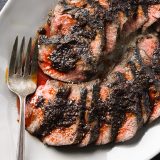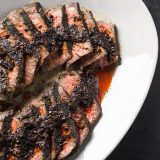In a stumbling dirt-floored shack perched at the edge of a long and desolate road in eastern Argentina, fields of waist-high grass waving in all directions, Jorge Biliota gently and somewhat absently pokes at red coals under a heavy cooking grate. Above them, sausages and steaks sizzle slowly, untended. A one-eyed dog waits eagerly nearby as century-old beehives are busted up to feed the fire.
Thirty minutes pass this way. Biliota stirs stained jars of homemade hot sauce and chimichurri. He fusses with baguettes toasting at the edge of the meter-long grill. He is in no rush, and the meat is mostly ignored. He tells me about the bees he keeps in the fields behind. He shows off his business certificate, official permission to feed 10 or so random truckers a day.
Finally, mostly by intuition, he declares the untouched meat done, slapping a chorizo—skin crackling and spurting fat—into a baguette. It is perfectly cooked—meaty, greasy, salty, spicy and tasting richly of the smoke that bathed it.
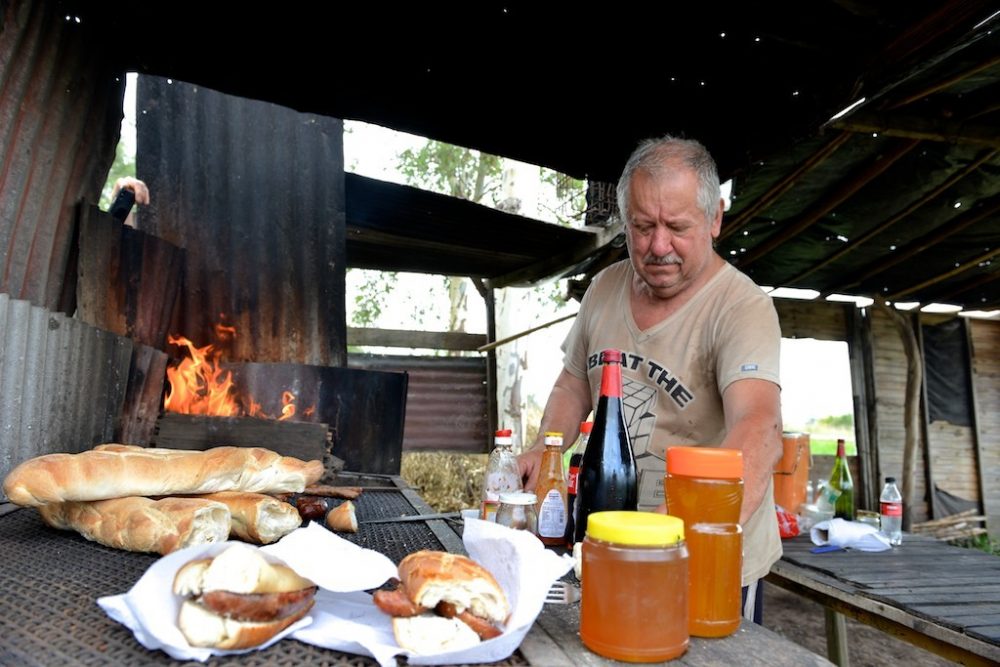
Jorge Biliota cooks for truckers along a desolate road south of Buenos Aires.
About 160 kilometers north in Buenos Aires—where arching sycamores shade wide, genteel lanes—another massive grill saturates the air. Several meters long, it has place of pride inside the soaring brick walls of Don Julio, one of the city’s most notable steakhouses. Below me, a 14,000-bottle wine cellar. Around me, crisp waiters proffer glasses of sparkling wine.
Owner Pablo Rivero seemingly shares little with Biliota. Until the conversation moves from the restaurant’s butcher shop beginnings to his almost spiritual notions of meat and how to prepare it. In a word—minimally.
“We work with the nakedness of the beef,” he says. Over his shoulder, I see thick marbled steaks cooking high above lightly glowing coals, unwatched. “The principle art of the parrillero [grill master] is patience.”
Unstated, but obvious, Rivero and Biliota’s commonality is in their message. Americans work too hard, worry too much at the grill. In Argentina—where beef isn’t a meal, but a lifestyle—the meat marries the fire with little fuss from the cook. It was a lesson that would inform a week of eating my way across Buenos Aires to understand Argentinian steaks.
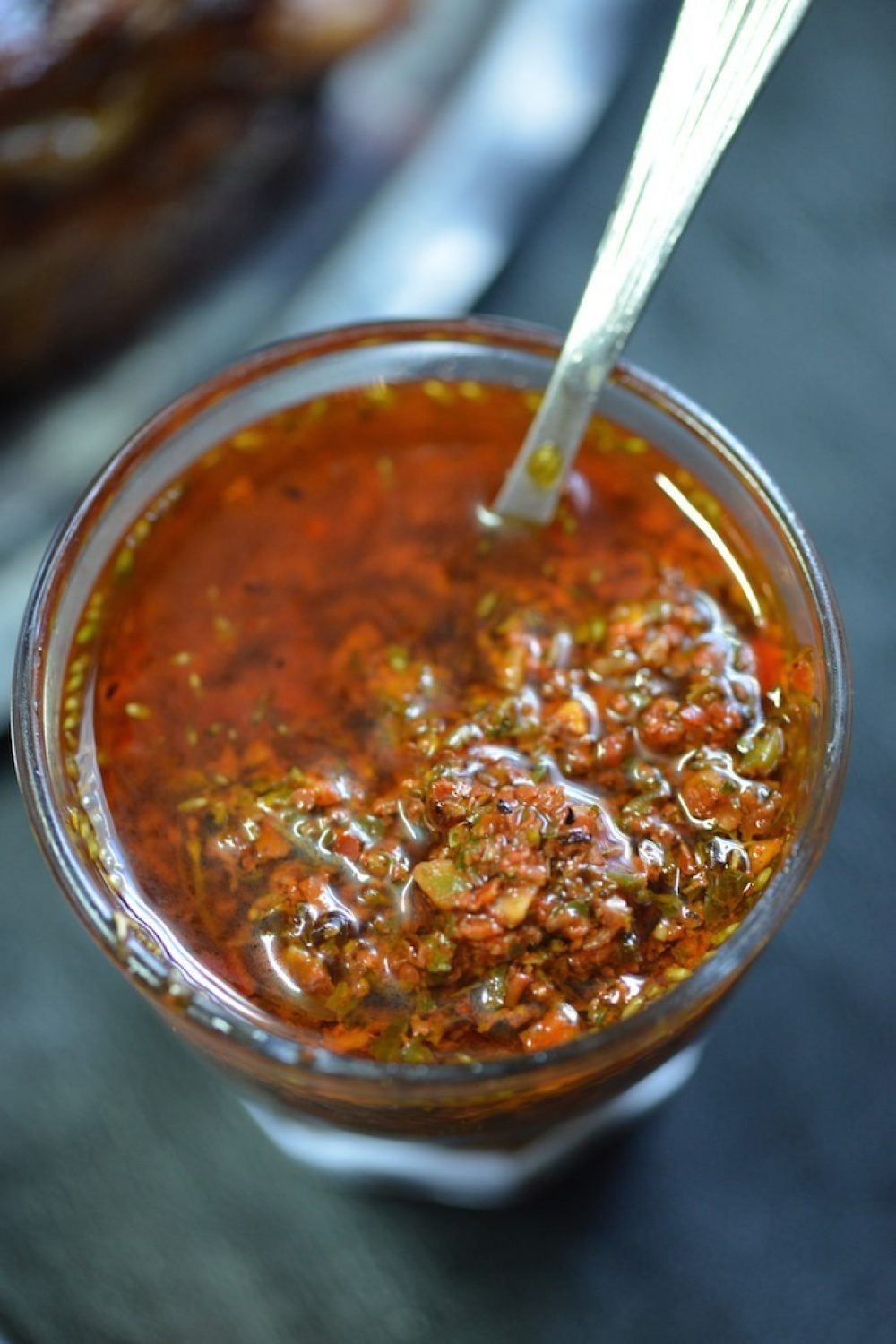
Argentinian Chimichurri
The Chimichurri in Argentina is nothing like the green pesto-like sauce we know in the U.S.
The Sauce
There is an almost religious fervor to grilling beef here. Every home has a parrilla (pronounced par-EE-zja), or wood-fired grill, in the backyard. Every week is structured around an asado, or barbecue. Poetry and songs extol it. All of which explains how Argentinians manage to eat more than 120 pounds of beef a year, roughly twice that of Americans.
My search for lessons that could be brought home begins at Parrilla Tito, also known as Tito’s Secret Steak House. Aptly named, as it is hidden behind a green iron security gate marked with a sign that reads “Cerrado.” Closed. It’s by design, an effort to keep it locals only. But if you are lucky enough to find it, the grill greets you at the door with waves of heat, smoke and fat. Walls are plastered with sporting posters. Chalkboards advertise inexpensive malbecs.
At the grill, parrillero Guillermo Abalsa uses a rake to pull blistering coals from a fire pit on the right, sliding them in an even layer under the long cooking grate. Above, large slabs of flank steak, rib-eye, tightly rolled, egg-stuffed matambre and whole flattened chickens slowly sizzle. Salt is added liberally, granules so large most bounce off and onto the coals below.
One of just about everything comes to the table. All delicious—the steak, of course, perfectly seared and perfectly rare, if a bit underseasoned—but the unexpected star of the spread is a tiny clear drinking glass filled with a thick herb-flecked, deeply red sauce. It smells richly of garlic and oregano. I taste it and get a bright burst of vinegar, spice and herbs.
It’s like nothing I’ve ever tasted, but Abalsa assures me—this is chimichurri, Argentina’s obligatory sauce for just about any grilled meat. But it’s no chimichurri I know, in the U.S. typically a green pesto-like sauce made with copious cilantro. This is a simple mix of paprika, dried oregano, red pepper flakes, garlic, salt, vinegar and oil. It’s such a delicious explosion of flavor, I use hunks of steak to sop the glass dry.
The Seasoning
One steak, one parrilla after another, I encounter the same chimichurri, all delicious iterations. But I also encounter the same problem—underseasoned steaks. Over and again, I watch cooks sprinkle the meat liberally with surprisingly coarse salt—granules two or three times the size of kosher—that immediately scatters off. Unexpectedly, the better approach came via France.
At La Cabrera, you see the line of people before you see the restaurant. They are waiting for the start of Meat Happy Hour, sale-price steaks that fill the restaurant early each evening. Chef Gastón Riveira brings a bottle of wine and fills my table with one of just about every cut of beef on the menu. As he discusses the nuances, I taste. THIS is the steak I came for. So perfectly cooked and so perfectly seasoned and meaty. I ask about it and he smiles, then rushes to the kitchen.
When he returns, he is holding a small bowl with what looks like fine salt and ground pepper. I assume the improved seasoning is because he is using a salt small enough to adhere to the meat. But that’s only part of it. When I taste the mixture, there is an immediate meatiness to it, something at once savory and aromatic.
Nutmeg, he explains. A trick he learned when he worked in France. A trick I knew we’d adopt at Milk Street.
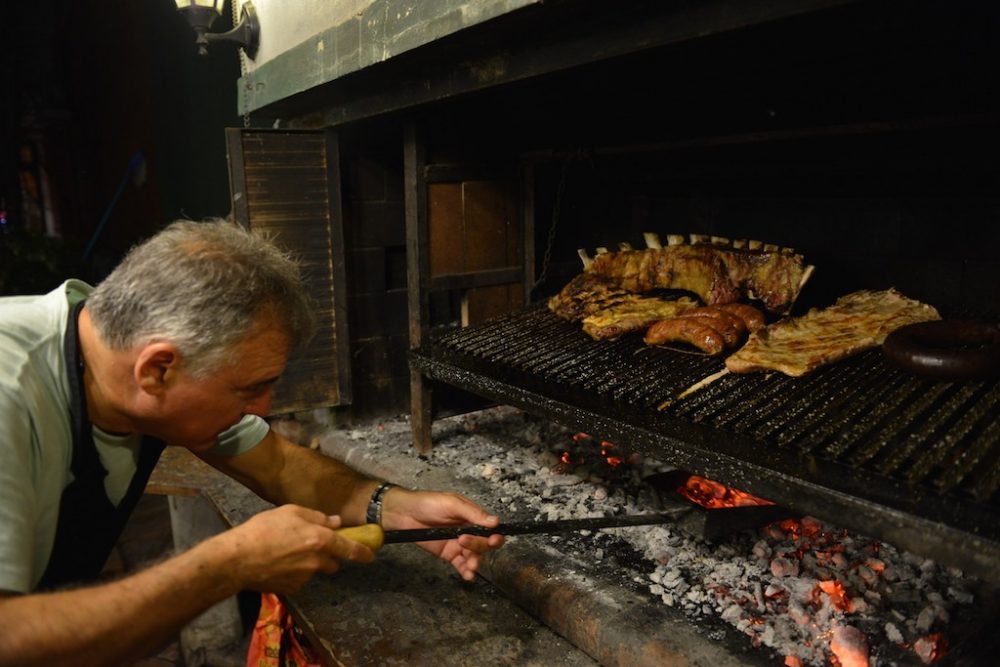
Ricardo Cárcova tends the coals to ensure the meat cooks slowly over low heat for several hours.
The Sizzle
I knew how to sauce it. I knew how to season it. Now I just needed to know how to cook it. Repeatedly, I was told to simply set the steaks over the fire and leave them be, other than to turn them once or twice. A good goal, but surprisingly unhelpful when you are trying to understand what separates a great steak from a merely good one.
To see it all start to finish, I wheedled myself an invitation to a backyard asado, 10 longtime friends who gather regularly in an ivy-walled courtyard for their session with wine and steak. The menu: more than a dozen pounds of flank steak, beef short ribs and matambre. A case of malbec. Chimichurri, of course.
Ricardo Cárcova, the asador—the cook who will run the grill—is a retired photo editor who now raises 150 cows on a farm about 200 kilometers outside Buenos Aires. He stations himself at the massive grill, igniting hardwood in a side chamber and letting it burn until glowing. After about an hour, he uses a long metal prong to drag the hot coals under a long cooking grate that can be raised or lowered. Cárcova lowers it close to the heat to clean it, then raises it well above the coals for cooking.
He invites me to hold my hand above it. I expect to flinch, but easily keep my hand in place for 5, 10, 20, 40 seconds. It’s that cool. He arranges the meat—all thick, hearty cuts, all seasoned simply with salt—over the coals and walks away. It will be two hours before he does anything more than turn them—and that, just once or twice.
When he decides the meat is done—no thermometers, thank you—he banks fresh coals under the grate and lowers it for a quick, final sear. That’s when everything I’d eaten makes sense. He’d used the so-called reverse sear method—slowly bringing the meat up to a desired internal temperature without browning the outside, then quickly searing it to finish.
The result is astounding—succulent steak with a rich exterior and a tender, bright red center. Paired with chimichurri, it is so good I just need everyone around me to stop talking for a moment so I can enjoy it.
Back at Milk Street, we faced some obvious challenges. Not the least of which, American steaks generally are nowhere near as thick as those in Argentina. And few of us own grills that offer nearly the same control and flexibility as an Argentinian parrilla. Yet we knew that if we at least could adapt the overall approach—low, slow heat with minimal fuss—perfectly juicy, tender steaks were almost guaranteed.
Thick-cut steaks were essential. After trying a butcher shop’s worth of options, we found that 2-inch-thick bone-in rib-eyes and well-marbled strip steaks were the most reliable choices. Yet even then, despite numerous attempts using indirect heat on the grill—placing the meat near, but not directly over the heat—our steaks still cooked too quickly.
On a whim, we experimented with the more even—and more easily controlled—heat of the oven. Cooked at just 250°F, our steaks could be left untended for nearly an hour without browning. For the browning, we considered the broiler, but these can be erratic and vary too much oven to oven. Instead, we borrowed a technique we’d seen at many parrillas—we transferred the steak to a blistering-hot cast-iron skillet for a quick stovetop sear. The results were perfect (though for purists, we also sussed out how to get the perfect sear on gas and charcoal grills).
Seasoning the meat was simple. We adopted Riveira’s nutmeg-based salt and pepper approach, with one addition. To help promote our quick pan sear, we added a small amount of sugar to the mix. We also took a lesson from him for our chimichurri. Most is made with white vinegar, but he prefers balsamic for the subtle sweetness it offers. We agreed. And while most versions are made by simply stirring together the ingredients, we found briefly warming them bloomed the seasonings in the oil and gave us deeper flavor.
The result? A perfectly seasoned, cooked and sauced steak that asks almost nothing of the cook. No parrilla needed.
